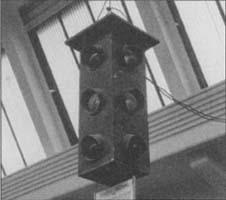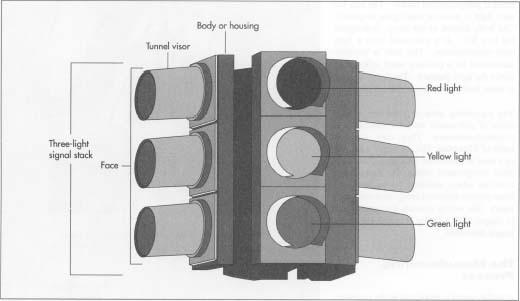Traffic Signal
Background
A traffic signal, or stoplight as it is also known, controls vehicle traffic passing through the intersection of two or more roadways by giving a visual indication to drivers when to proceed, when to slow, and when to stop. In some cases, traffic signals also indicate to drivers when they may make a turn. These signals may be operated manually or by a simple timer which allows traffic to flow on one roadway for a fixed period of time, and then on the other road-way for another fixed period of time before repeating the cycle. Other signals may be operated by sophisticated electronic controllers that sense the time of day and flow of traffic to continually adjust the sequence of operation of the signals. Traffic engineers use signals to avoid traffic congestion and improve safety for both motorists and pedestrians alike.
The first illuminated traffic signal was installed in London, England, in 1868. It was manually turned and consisted of two gas lamps, one red and one green, with semaphore arms atop a pole. Shortly after its inauguration it blew up while the lamps were being lit and killed a policeman. The first electric traffic signal was installed in Cleveland, Ohio, in 1914. It consisted of a green and red light with a warning buzzer to indicate when the light was about to change. The first signal to use the familiar green, yellow, and red lights was installed in New York City in 1918. It was operated manually from an elevated observation post in the middle of the street. In Los Angeles, traffic lights consisted of green and red lights used in conjunction with a warning gong and a pair of semaphore arms lettered "stop" and "go."
A modern traffic signal system consists of three basic subsystems: the signal lights in their housing, the supporting arms or poles, and the electric controller. The signal lights and housing are known as the signal light stack. A single stack usually consists of three lights: a green light on the bottom to indicate the traffic may proceed, a yellow light in the middle to warn traffic to slow and prepare to stop, and a red light on the top to indicate the traffic must stop. Because some people are red-green color blind, there has been an effort to standardize on a vertical stack of lights with red at the top so that these people can perceive the signal condition by the position of the light rather than the color. Each light has a fresnel lens which may be surrounded or hooded by a visor to make it easier to see the light in bright sunlight. A fresnel lens consists of a series of concentric angled ridges on the outer surface of the lens which bend the light to focus it in a parallel beam. The light stack may have a dark-colored backing plate to make the signals more distinguishable by blocking out surrounding lights from buildings and signs. There are one or more signal light stacks for each direction of each roadway. The electric controller is usually mounted in a weather-proof box on one of the corners of the intersection. More elaborate traffic signals may also have electromagnetic sensors buried in the roadway to detect the flow of traffic at various points.
Raw Materials
The housing or body of each signal light stack is usually made of corrosion-resistant aluminum. Some housings are made of molded polypropylene plastic. The lens for each light is made of tinted glass or plastic. The bulb, known as the lamp, is designed for long life. It is purchased from a light bulb manufacturer. The bulb is partially. surrounded by a polished metal reflector to direct the light forward. The hood or visor is made from aluminum or molded plastic.
The supporting arms or poles are usually made of galvanized steel for strength and corrosion-resistance. They may also be made of fiberglass. The controller is housed in a steel or aluminum enclosure. The electrical components within the controller—switches, relays, and timers—are purchased from various electrical component manufacturers. The wiring between the components is copper with a heavy neoprene rubber or plastic insulation.
The Manufacturing
Process
A traffic signal is fabricated in the manufacturer's plant, then installed and wired at the site of the intersection.

The introduction of the automobile at the turn of the century was chiefly a matter of novelty, and early streets were not paved, engineered, or controlled for automobiles. The first autos joined horse-drawn carriages, pushcarts, horses, bicycles, and pedestrians on the streets.
Initially traffic control was simply non-existent. People and vehicles negotiated their own way through intersections without control. In urban areas police officers eventually tried to direct traffic and soon employed "Stop-Go" hand signs. Problems constantly arose as officers changed the signals with no advanced warning, and motorists found themselves stopping in the middle of the intersection or coming to a near stop each time they approached an intersection. Either way, traffic did not flow so much as it lurched along.
Morgan Garrett, an African American entrepreneur and inventor, experimented with automatic traffic signals in the early 1920s. His first version, placed in the middle of the intersection, worked like a railroad semaphore, with the arms moving to different positions to signal drivers coming from different directions. Garrett's main innovation was the introduction of an intermediate position, the equivalent of yellow on a modern traffic light. This allowed motorists to anticipate a change and slow down only when necessary. Garrett later sold his invention to the General Electric Co., which later made electric, three-light, four-way traffic signals.
William S. Pretzer
Making the signal stack
- 1 The housing or body of each signal stack is die cast, as are the lens door and the bulb door which attach to the body. They may be cast as individual housings and doors for each light, or as larger units for each stack. The die-casting process uses a large, two-piece, steel mold called a die. Inside the mold, called the cavity, is the reverse image of the part to be cast. The die is placed in a machine which clamps the two halves together with a force of 2,400,000 pounds (1,090,000 kg). Molten aluminum is poured into the "shot end" of the die, and a plunger rams the metal into the cavity under a pressure of approximately 2,000 pounds per square inch (138 bar). The molten metal is forced into every portion of the cavity and cools. After about 15 seconds, the die is opened and the hot part is ejected. The part is then cooled for about 30 minutes. Under normal conditions a die-casting machine like this can produce about 30 parts per hour.
-
2 Once the cast part is cooled, it is trimmed. The trimming process uses
a stamping die to shear off any excess metal. The part is then visually
inspected, and a hand file is used to remove any sharp burrs. The points
where the doors are to mount to
the housing are machined to ensure they will fit properly. The doors are attached to the housing with hinge pins and retained by spring latches. If the housings and doors have been cast individually, they are assembled to form the stack. The holes used for fastening the stack to the support structure are drilled. The stack is cleaned, painted, and placed in a drying oven.
 Malor components of a traffic signal.
Malor components of a traffic signal. - 3 The painted stack is transferred to a final assembly area where the lamps, lampholders, reflectors, and lenses are installed. Stainless steel screws and fasteners are used. The lenses are sealed against the lampholder assembly with weatherproof gaskets. The sheet metal visors, which were fabricated in another operation, are attached to each light. Wiring from each light is routed through the hollow stack housing to the stack mounting point.
Making the controller
- 4 The housing for the electrical controller may be cast or fabricated. It is trimmed, machined, and painted in much the same manner as the signal stack. Inside it has mounting points to which the electrical control boards are attached. The traffic signal manufacturer may assemble the electrical components, or may have this done by another company.
Making the supports
- 5 The supports may be cast, spun, or fabricated. Supports are hollow with an electrical junction box built into the base to connect with the wires coming underground from the controller. Some supports include decorative details to make the signals fit in with the architecture of the surrounding area. In some signal installations the light stacks are hung from heavy steel cables spanning the intersection.
Installation
- 6 Underground electrical conduits between the controller and each signal support location are put in place and connecting wires are pulled through the conduits. Power for the signal is brought to the controller location. If sensors are to be placed in the road, they are connected to the controller as well. The supports are bolted in place, and wires are pulled through the hollow supports between the base and the signal stack mounting point. The signal stacks are attached to the supports. The wiring is then connected between all the elements of the system. Each individual light is given a final adjustment to aim it properly, the sequence timers in the controller are set to the specifications determined by the traffic engineers, and the system is cycled several times to test for proper operation of each element.
Quality Control
The manufacturing process for traffic signals is subject to the standard inspections and control practices found in any similar production facility. These include both conventional and statistical methods. The installation on the job site is subject to review by an electrical inspector from the agency placing the signal. Wiring must comply with the National Electrical Code. The location of the light and any other structural considerations must also meet various federal, state, and local ordinances. A registered professional engineer must review and approve the plans to ensure the installation meets the national requirements for traffic control devices.
The Future
With the ever-increasing use of computers, traffic signals in the future will become more sophisticated. Many systems already feature a remote-controlled activation system which allows fire engines and other emergency vehicles to change the signal to green in their direction as they approach an intersection. Some cities are developing networks of traffic signal controllers that interact to keep traffic moving through heavily congested areas or reroute traffic during peak traffic hours. Other advances might include integrating speed warning devices and systems to check for stalled traffic or accidents.
Where To Learn More
Periodicals
Loggins, J.W. "New Traffic Signal Concepts." Public Works. March 1993.
Nadis, S.J. "Gridlock Terminator: Neural Nets Predict the Traffic Future." Omni, October 1994, p. 22.
— Douglas E. Betts
Chris Cavette
Thank you
Mbulelo